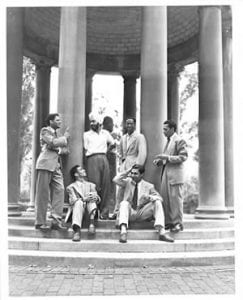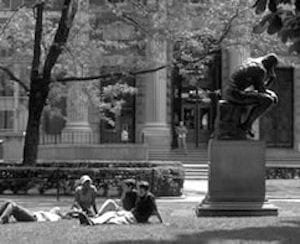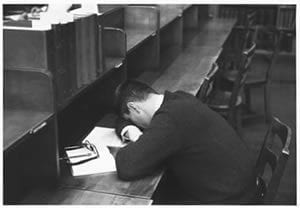A History of MESAAS
 Columbia University, founded as King’s College in 1754 under a charter from the British crown, appointed its first Professor of Oriental Languages in 1784. The appointment coincided with a change in direction for the college. Forced to suspend instruction during the Revolutionary War, when Manhattan served as the base for British military operations, the institution had reopened that year as Columbia College, a name intended to indicate a break with its colonial past.
Columbia University, founded as King’s College in 1754 under a charter from the British crown, appointed its first Professor of Oriental Languages in 1784. The appointment coincided with a change in direction for the college. Forced to suspend instruction during the Revolutionary War, when Manhattan served as the base for British military operations, the institution had reopened that year as Columbia College, a name intended to indicate a break with its colonial past.
Defeated in the thirteen colonies, British colonialism was expanding in India, where the Orientalist William Jones established the Asiatic Society of Bengal in the same year as the teaching of Oriental Languages began at Columbia. Jones noted that European languages shared a common root with old Persian and Sanskrit (the great Delhi philologist Siraj al-Din Ali Khan Arzu had noted the affiliation of Sanskrit and Persian some 30 years earlier). The discovery gave birth to comparative philology, the field that over the following century came to represent the pinnacle of humanistic scholarship in Europe.
 At Columbia, despite the early commitment to teaching Oriental languages, repeated efforts to organize the wider study of comparative philology failed, even after 1857 when the college moved from its original home on Park Place, at the southern end of Manhattan, to Forty-Ninth Street, where it began to establish graduate education. In the later nineteenth century, however, the study of Hebrew, Sanskrit, and other Oriental languages became part of the graduate program in the School of Letters.
At Columbia, despite the early commitment to teaching Oriental languages, repeated efforts to organize the wider study of comparative philology failed, even after 1857 when the college moved from its original home on Park Place, at the southern end of Manhattan, to Forty-Ninth Street, where it began to establish graduate education. In the later nineteenth century, however, the study of Hebrew, Sanskrit, and other Oriental languages became part of the graduate program in the School of Letters.
By 1890, as Columbia completed its transformation from an undergraduate college into a university, and prepared a second move, to Morningside Heights on the Upper West Side of Manhattan, Oriental Languages formed one of the six departments of the new Faculty of Philosophy. A chair in Indo-Iranian Languages was established the following year. A.V. Williams Jackson (1862-1937), who obtained his Ph.D. at Columbia in 1886, was appointed to the chair in 1895. In addition to teaching philology, members of the department offered courses on the history of the Arabs, of India and Persia, and of West Asia and Egypt. (See A History Of Columbia University 1754-1904, 1904)
The scholars of Indo-Iranian philology subsequently broke away to join the anthropologist Franz Boas in the new Department of General and Comparative Linguistics. Oriental Languages, under the leadership of Richard Gottheil, narrowed its name to the Department of Semitic Languages. Gottheil trained several scholars who went on to organize and lead other departments, including William Popper (later chair of the Department of Near East Languages at Berkeley) and Philip Hitti (founder of the Near Eastern Studies program at Princeton).
 The attempt to combine the general linguistics of Boas with the comparative philology of Oriental studies was unsuccessful. In 1954, the Indo-Iranian philologists reunited with Semitic studies to form the Department of Near and Middle East Languages. A scholar of Turkic philology, Tibor Halasi-Kun, joined the new department at the same time, adding Ottoman and Central Asian studies. Joseph Schacht, the leading Western scholar of Islamic law, formerly Professor of Oriental Languages at the Egyptian University in Cairo, joined the department in 1957.
The attempt to combine the general linguistics of Boas with the comparative philology of Oriental studies was unsuccessful. In 1954, the Indo-Iranian philologists reunited with Semitic studies to form the Department of Near and Middle East Languages. A scholar of Turkic philology, Tibor Halasi-Kun, joined the new department at the same time, adding Ottoman and Central Asian studies. Joseph Schacht, the leading Western scholar of Islamic law, formerly Professor of Oriental Languages at the Egyptian University in Cairo, joined the department in 1957.
In the mid-1960s, the department changed again. It expanded to include scholars from the Columbia departments of history and international affairs, including the South Asia historian Ainslee Embree, and briefly (in 1967) from government and economics, and it moved into new offices in Kent Hall. Reflecting the expansion into modern history and politics, the name was revised once more, in 1965, from Near and Middle East Languages, to Middle East Languages and Cultures, or MELAC.
In 1992 the name was changed to Middle East and Asian Languages and Cultures. Using the term Asian rather than South Asian made the name scarcely more accurate, but ensured that the department’s new acronym, MEALAC, sounded the same as its previous one.
In 2005, the Department began the most rapid expansion in its history, recruiting a number of faculty in South Asian and Middle Eastern Studies, and in 2007 it extended its geographical and intellectual scope to include African studies. After doubling in size over the previous decade, the department had outgrown its home in Kent Hall and in 2009 moved to new offices in Knox Hall. To coincide with the move and the expanded focus, the faculty decided to change the department’s name to MESAAS, the Department of Middle East, South Asian, and African Studies.

